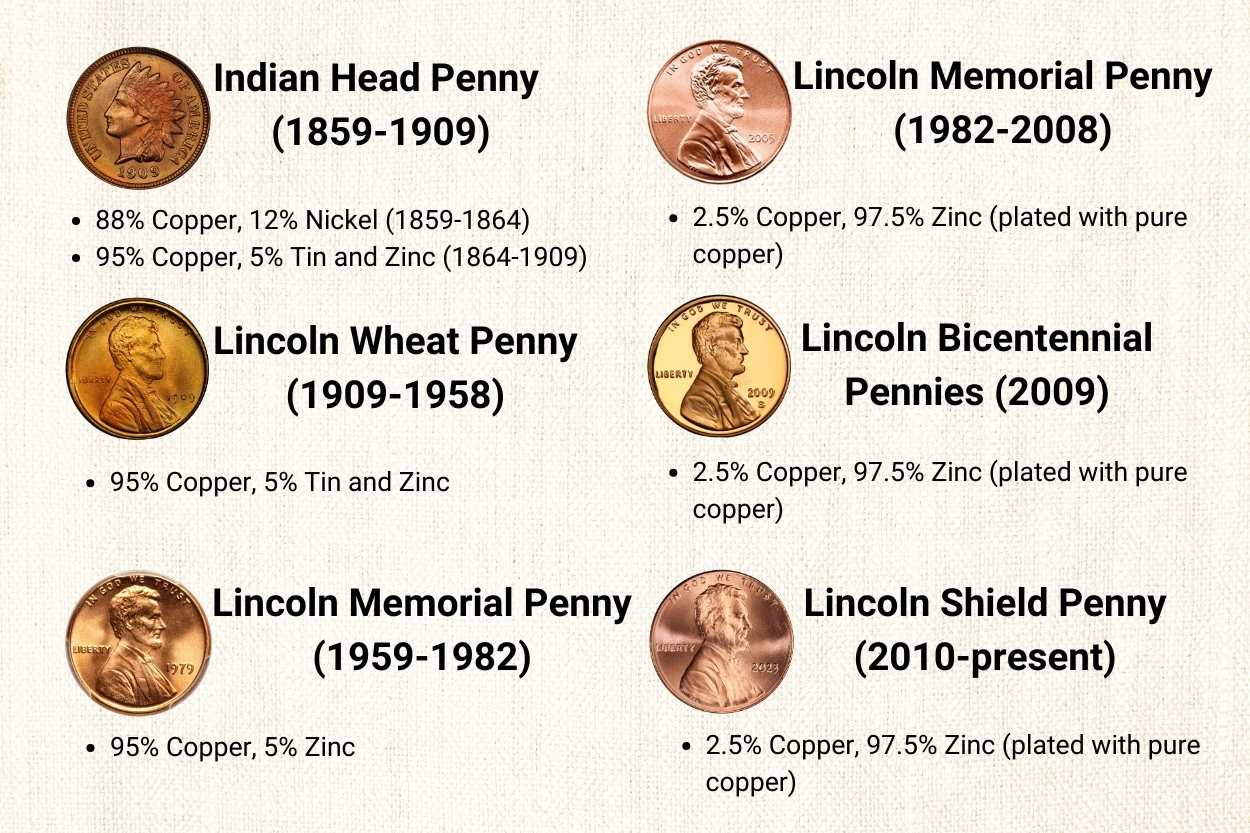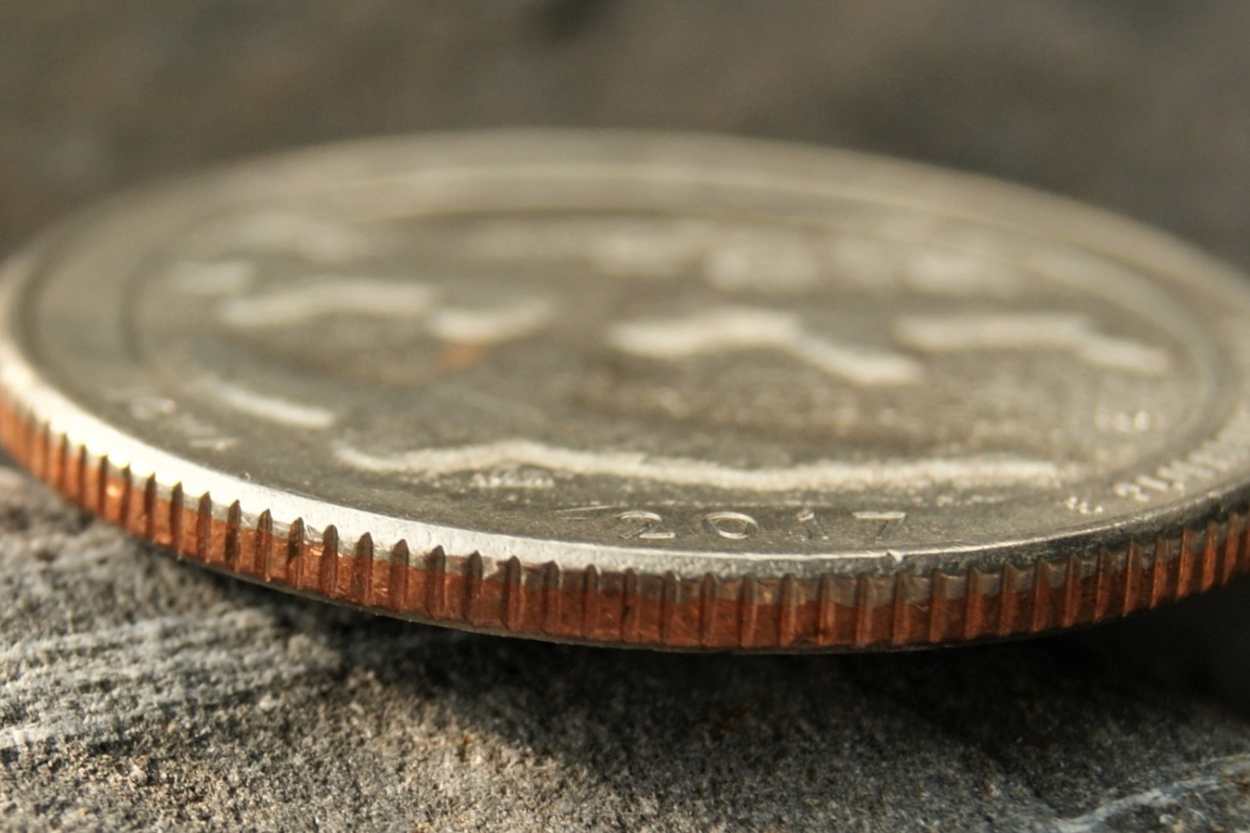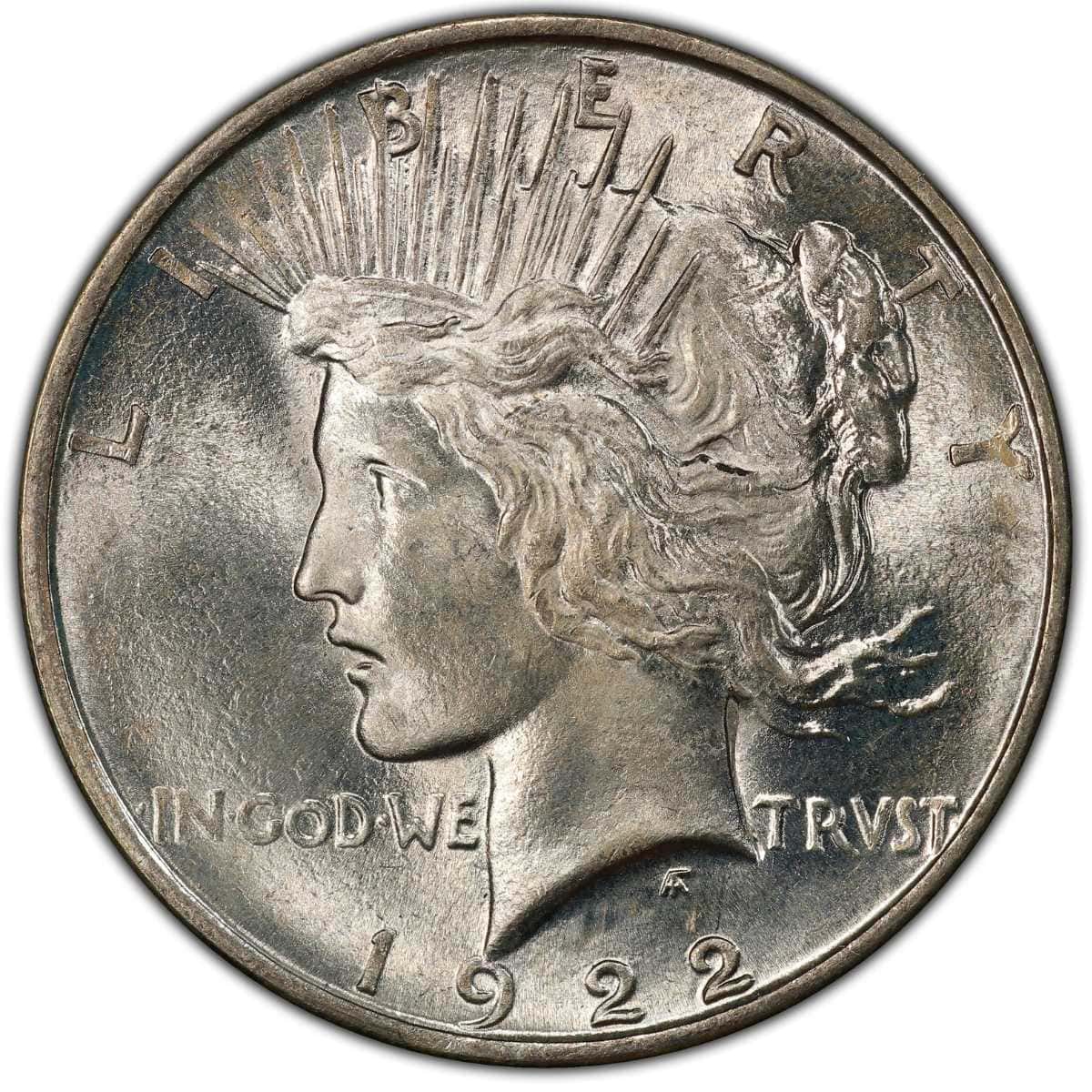In the thick of World War II, the U.S. Mint transitioned the Lincoln Penny from the traditional bronze planchets to steel planchets. In the immediate aftermath of that transition, merchants complained that they often confused the 1943 Steel Penny with dimes and nickels on account of color.
That’s how important coin color is in the commercial world. In the numismatic realm, color can have more serious implications as it may affect the value of a coin. In this guide, we’ll discuss coin color, the factors that affect it, and its implication on coin value.
But first, let’s review the natural colors of modern U.S. coins.
| Denomination | Color |
| Penny | Copper |
| Nickel | Silver |
| Dime | Silver |
| Quarter | Silver |
| Half Dollar | Silver |
| Dollar Coin | Pre-2000 – Silver
Post-2000 – Gold |
Factors Influencing Coin Colors

You may be looking at the table above and wondering why the penny on your dresser is turning green, yet it should be bronze in color. Well, coins take on certain colors because of the many influences around them. Below are just a few of these influences and how they affect the color of our coins.
Metallic Composition of the Coin
All U.S coins are made from a combination of metals. Using metal alloys started as a way of strengthening silver and gold in preparation for minting. But since the U.S switched to base metals, the U.S. Mint is using different combinations to achieve specific coin colors.
Let’s look at how different alloys influence the color of U.S. coins.
Copper and Zinc Alloys

This is one of the primary alloys that has been used to make pennies. Copper is reddish brown, while zinc is silver colored. Copper and zinc alone make a beautiful combination of metals, but adding tin into the mix is a game-changer. Besides adding strength and corrosion resistance to the alloy, tin gives the penny its signature bronze appearance.
Copper-Nickel Alloys

Apart from a brief stint during World War II, Nickel planchets have been made from a copper-nickel alloy. The silver-colored nickel supplies the coin with its color, while copper takes on a filler role. However, when the nickel wears down, your Jefferson Nickel will start to show the red toning of the copper underneath.
Silver and Copper Alloys

This was the U.S. Mint’s favorite mode of making dimes, quarters, half dollars, and dollar coins before 1965. They would add a smidge of copper to strengthen their planchets for the strike, but up to 90% of the coin was made of silver. As the dominant metal, silver donated its color to the coin with little contest.
Clad Alloys

Authorized by the Coinage Act of 1965, the U.S. Mint did away with the silver alloys in favor of clad coins. These planchets were known as the Johnson Sandwich, and they had a copper core between a copper-nickel cladding. If you study the edge of your post-1965 Dimes, Quarters, and Half Dollars, you’ll see the red-brown copper core sandwiched between the silver-colored copper-nickel clad.
Minting Process
Now that you know how metals give coins their colors, it is important that you also know how the minting process affects the colors of coins. Before planchets can be struck, they undergo additional processes to prepare them for the dies.
One process that is particular in molding a coin’s final color is planchet annealing, which is a heating process that mints use to prepare their planchets for striking. Planchet annealing brings out a consistent coloration on the surface of a coin. For the Lincoln Penny, the heating process brings out that red bronze color synonymous with freshly minted pennies.
While surface finishes do not change the color of a coin, they alter their luster. Matte finishes tone down luster, while satin finishes induce the opposite effect.
Striking coins also affects the perceived color of coins. If a coin is well-struck with high reliefs and deep fields, it will show more shadows, darkening the coin when you view it at certain angles. It doesn’t change the color, but your eyes will be convinced that the coin is darker than the shallower alternatives.
Environmental Factors
Once coins leave any of the mints, they are at the mercy of the elements. Sure, few will find themselves in the caring hands of collectors who will store them in plastic coin holders, but most of them will be pumped into circulation.
While the simplest definition of circulation is the exchange of coins, many fail to consider that these tokens are exposed to air, moisture, and chemicals during their time in circulation. These environmental influences affect the colors of coins via oxidation, abrasion, and corrosion.
Common Coin Colors
Now that you know the common factors that influence the color of coins, it’s high time we discussed how these influences affect common U.S. coins
Copper Coins

We’re using the word “Copper” here to describe copper-colored coins loosely; in other words, the penny. Naturally, copper is reddish brown, and so is the penny. The early pennies (large cents and half cents) were treated in heat to darken their red complexion and give them that burnt-brown appearance.
For the modern pennies, the U.S. Mint altered the heating process to bring out the Lincoln Penny’s signature red bronze appearance. As the penny ages, it sheds its red color for a brown tone. This transition between colors has given us the three sub-varieties of the Lincoln Penny: the Red(RD), Red-Brown(RB), and Brown(BN).
But that’s not the end of the color transition. You see, copper is a weird metal; it may be naturally red-brown, but under the influence of certain chemicals, it changes color. When it oxidizes, the penny develops a green patina, just like the Statue of Liberty (also made of copper).
Silver Coins

The majority of U.S. coinage is silver-colored. I’m talking about nickels, dimes, quarters, half dollars, and some dollar coins. Some pre-1965 versions of these coins contain actual silver, while the rest obtain their silver color from nickel.
Naturally, silver is icy white, like a chunk of hazy ice. Like our copper coins, silver-colored coins are also susceptible to the elements. When exposed to small amounts of sulfur, water, and oxygen, silver develops a rainbow toning. When the stars align perfectly, this patina makes the coin incredibly attractive and valuable.
While nickels rarely adopt a rainbow toning, they wear revealing the copper underneath. A worn Jefferson Nickel will show a feint reddish brown tone, adopting a vague rose gold appearance.
Gold Coins

U.S. coinage has its fair share of golden coins. There’s the Gold Dollars and the Golden Eagles. Freshly minted gold coins will have the shiny yellow-orange color of gold. Pure gold does not tarnish, but the copper in the coin does.
The Liberty Gold Dollars contain 90% gold and 10% copper. As the copper tarnishes, it mutes gold’s natural luster, leaving a coin with a muted shine.
And while the Presidential Dollars do not contain any gold, they do appear golden. These coins are fairly new, with the Washington Presidential Dollar released in 2007. We are yet to determine how these coins will age, but time will tell.
Coin Color and Value
To a certain extent, a coin’s color does play a role in its value. The perfect example of this effect is among the Lincoln Cents. Red Lincoln Pennies are generally more valuable because of the retention of the red pigmentation, an indication of the coin’s mint condition.
Then again, oxidation among the Lincoln Pennies hurts their value, while oxidation among the silver coins boosts their value.
In the numismatic realm, eye appeal is huge! A green penny won’t attract a lot of attention, while a silver coin with a beautiful rainbow toning will. But that is not to mean that every silver coin with a rainbow toning is deserving of a high price tag. Examples with brighter and continuous toning will attract more attention and, consequently, higher bids.
Artificial Toning
Two 1881 Barber Silver Dollars were auctioned off on Heritage Auctions. While both coins were graded MS66, one had a beautiful rainbow toning while the other didn’t. The Silver Dollar with the rainbow toning sold for $6,600, while the other coin sold for $4,025. The difference in price between the two coins is $2,575, just enough motivation for con artists.
It’s not uncommon for unscrupulous collectors to stain perfectly okay coins in the hope of making an extra buck. What they do is soak the coin for extended periods in a mixture of acetone, sulfur, baking soda, and water. Under these conditions, the outer layer of silver oxidizes, coating the coin with beautiful rainbow toning.
Luckily, with the tips below, you can detect artificially-toned coins:
- Under high magnification, artificially toned coins will show chemical residue on their surfaces
- When you wipe the surface of an artificially-toned coin with acetone, the patina will be wiped away.
- Artificially-tones coins will show significant variations in weight
- When shined with UV light, artificially-toned coins will show an unusual fluorescence.
Final Thoughts
It may sound cliche, but you can tell a lot about a coin from its color. You can guess how old it is and the conditions under which it was kept. As we’ve seen in this article, understanding the value of certain types of toning could just be the difference between losing out on a few thousand dollars or gaining thousands of dollars.
Besides just hoarding old coins, the numismatic realm is about celebrating the diversity of coins. Color is one of the factors that make coins unique.


Jenson is a professional numismatist, a dedicated coin collector, a graduate of the College of Business at Oregon State, a life member of the American Numismatic Association (ANA), and an overall coin nerd. He is the founder of Coin Value List.
